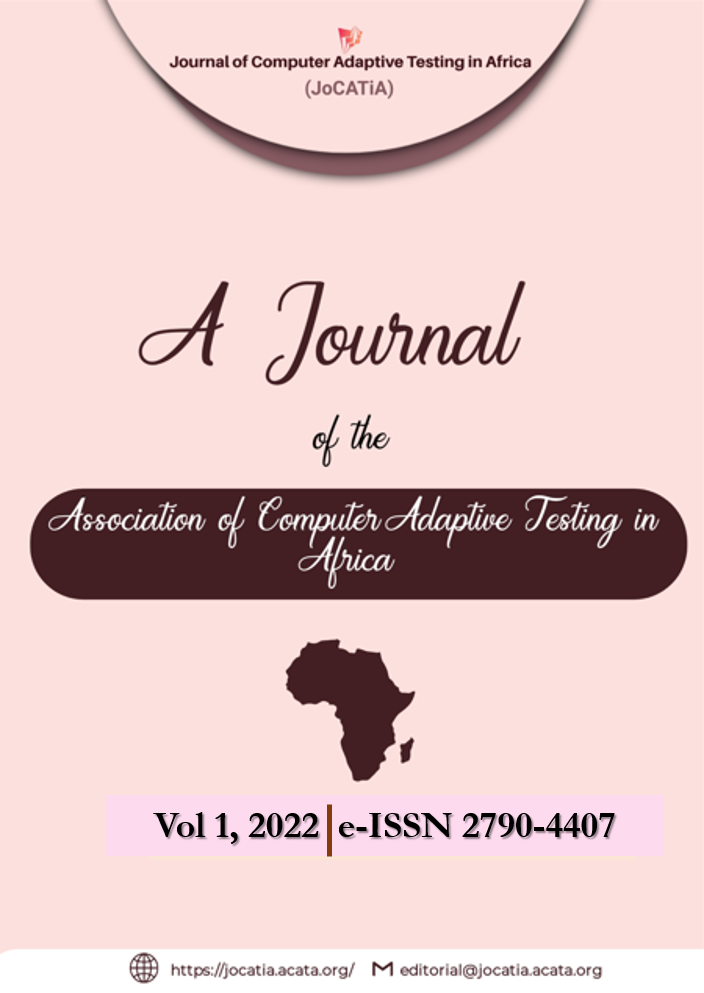Detection of differential item functioning magnitude in psychological measurements with missing data
DOI:
https://doi.org/10.71291/jocatia.v1i.16Keywords:
Achievement motivation inventory, differential item functioning, full information maximum likelihoodAbstract
The paper investigated the effectiveness of missing data methods in detecting differential item functioning magnitude in polytomous scored non-cognitive items with a view to determining different levels of magnitude existing in non-cognitive items and the difference in the ability of missing data methods to detect DIF magnitude. Using the sample of 1,500 senior secondary school students, drawn through multistage sampling technique from Osun State, data were collected with the Achievement Motivation Inventory (AMI). The result showed that with Full Information Maximum Likelihood (FIML) 81.3% possess small DIF magnitude, while 4 (12.5%) items possess moderate DIF magnitude, while high DIF magnitude occurs in 2(6.3%) items, and 24 (75.0%) were categorised as having small DIF magnitude, 2 (6.3%) with moderate DIF magnitude, while 6 (18.8%) was classified as having high magnitude of DIF using Multiple Imputation (MI). The result further revealed that item effect size (magnitude) across different methods did not distinctly differ from one another (X2 = 0.16, df = 1, p > 0.05). The study concluded that the two missing data methods were effective in detecting magnitudes of DIF present in polytomous scored non-cognitive items, and the differences that exist in the abilities of these missing data methods is not statistically significant.
Downloads
References
References
Awuor, R. A. (2008). Effect of Unequal Sample Sizes on the Power of DIF Detection: An IRT Based Monte Carlo Study with SIBTEST and Mantel-Haenszel Procedures. Unpublished Ph.D Dissertation submitted to the faculty of the Virginia Polytechnic Institute and State University
Baraldi N. A., & Enders, C.K. (2009).An introduction to modern missing data analyses.Journal of School Psychology 48 (2010) 5–37
Garrett, P. L. (2009). "A Monte Carlo Study Investigating Missing Data, Differential Item Functioning, and Effect Size." Dissertation, Georgia State University, 2009. https://scholarworks.gsu.edu/eps_diss/35
Kilmen, S. (2016). Effect of DIF Magnitudes, Focal Group Sample Size, and DIF Ratio on the Performance of SIBTEST. International J. Soc. Sci. & Education 2016 Vol.6 Issue 1, ISSN: 2223-4934 E and 2227-393X Print
Monahan, Mchorney, Stump and Perkins (2007). Odds Ratio, Delta, ETS Classification, and Standardization Measures of DIF Magnitude for Binary Logistic Regression. Journal of Educational and Behavioral Statistics Vol. 32, No. 1, pp. 92–109 DOI: 10.3102/107699860629803 _ AERA and ASA. http://jebs.aera.net
Muthee, J. M. & Thomas, I. (2009). Predictors of Achievement Motivation Among Kenyan Adolescents the Psyche space Vol. 3, No. 2, 39-44, July 2009.
Orley, G. J., Multiple Imputation of the Guessing Parameter in the Case of Missing Data (2017). Public Access Theses and Dissertations from the College of Education and Human Sciences. 288. Retrieved from http://digitalcommons.unl.edu/cehsdiss/288
Robitzsch, A., & Rupp, A. A. (2009). Impact of missing data on the detection of differential item functioning: The case of Mantel-Haenszel and logistic regression analysis. Educational and Psychological Measurement, 69(1), 18-34.
Rodriguez De Gil, P. (2015). An Empirical Comparison of the Effect of Missing Data on Type I Error and Statistical Power of the Likelihood Ratio Test for Differential Item Functioning: An Item Response Theory Approach using the Graded Response Model. An unpublished Ph.D Thesis of the University of South Florida
Schafer, J. L., & Graham, J. W. (2002). Missing data: Our view of the state of the art. Psychological Methods, 7(2), 147-177
Thissen, D., Steinberg, L., & Wainer, H. (1993). Detection of differential item functioning using the parameters of item response models.In P. W. Holland, & H. Wainer (Eds.). Differential item functioning, (pp. 130-215). Hillsdale, England: Lawrence Erlbaum Associates, Inc.
Zwick, R. (2012). A Review of ETS Differential Item Functioning Assessment Procedures: Flagging Rules, Minimum Sample Size Requirements, and Criterion Refinement. Retrieved from http://www.ets.org/research/contact.html, June 14, 2020
Downloads
Published
How to Cite
Issue
Section
License
Copyright (c) 2022 Alexander Oluwafemi, Femi Timothy Adekunle, Eyitayo Rufus Ifedayo AFOLABI

This work is licensed under a Creative Commons Attribution 4.0 International License.






